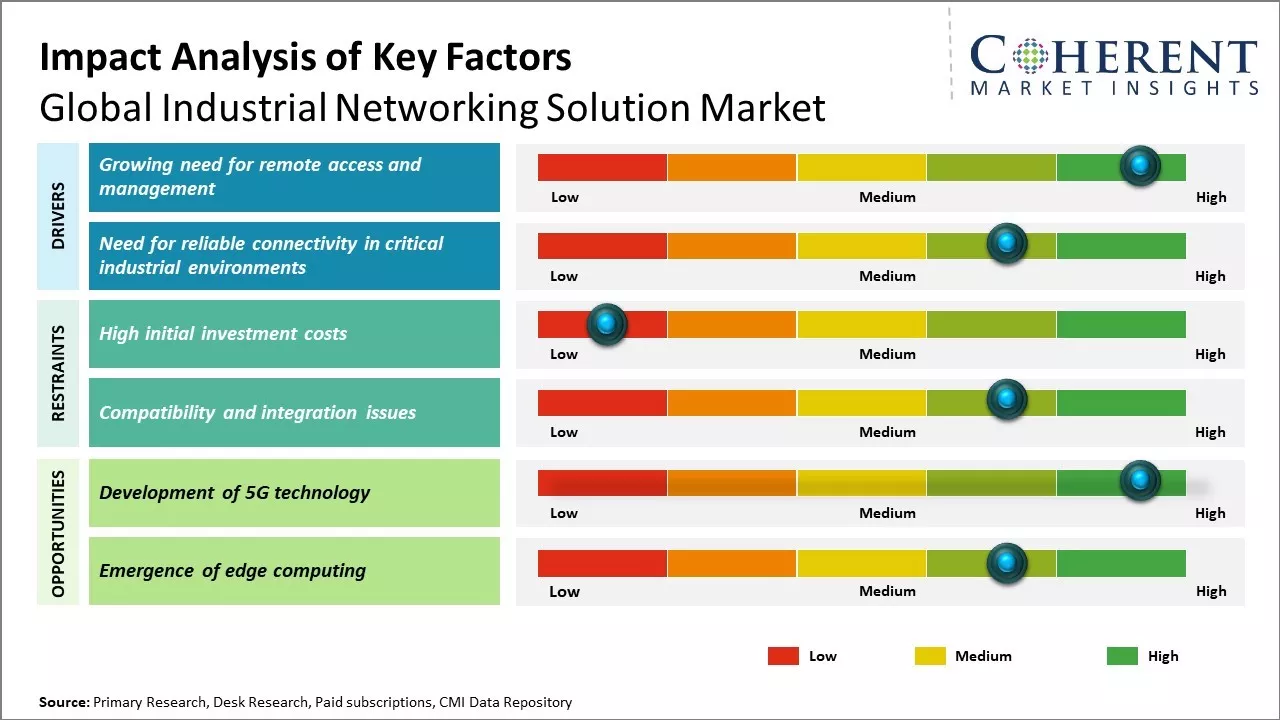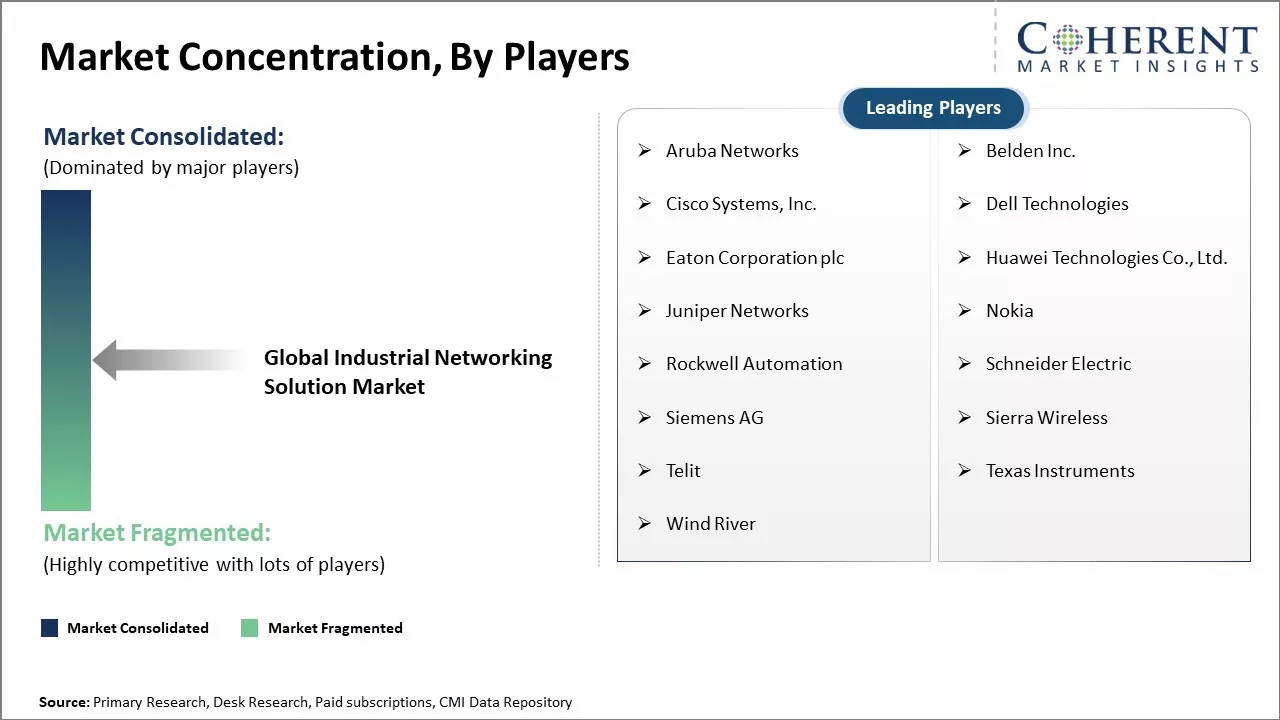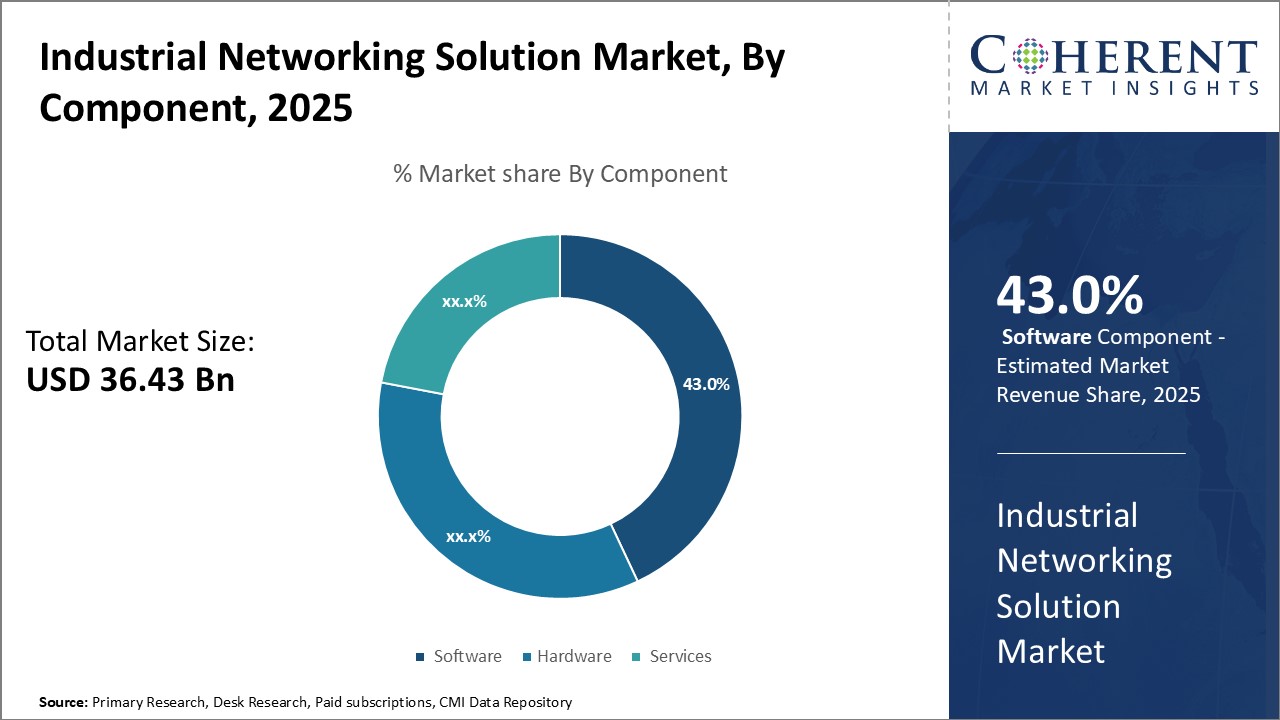Industrial Networking Solution Market Size and Trends
The Global Industrial Networking Solution Market is estimated to be valued at US$ 36.43 Bn in 2025 and is expected to reach US$ 134.47 Bn by 2032, exhibiting a compound annual growth rate (CAGR) of 20.5% from 2025 to 2032. The widespread adoption of industrial internet of things (IIoT) and increasing emphasis on networking infrastructure across production facilities are projected to drive significant demand for networking solutions in industries over the coming years.

Discover market dynamics shaping the industry: Download Free Sample
The market is anticipated to be dominated by Ethernet switches segment during the forecast period. Rising need for high-speed communication protocols to support modern automation needs in industries will lift the demand for Ethernet switches. Adoption of secure, scalable and reliable network infrastructure is expected to increase across industries like oil & gas, metals & mining, and automotive.
Drivers of the Market:
Growing need for remote access and management
With the rise of Industry 4.0 and focus on digital transformation, industrial operations are becoming more networked and reliant on cloud-based systems. Real-time data aggregation from machines and devices spread across geographies helps companies gain valuable insights and optimize processes. However, managing a dispersed network of industrial assets poses major challenges. Remote access and management capabilities are crucial to monitor performance, enable predictive maintenance, push software updates, reconfigure machines on the fly, and more. Networking solutions that support secure remote access are helping companies stay on top of their systems despite physical barriers. Technologies such as SD-WAN, edge computing, and wireless communication standards are empowering industries to access and control equipment from any location. This brings greater flexibility and responsiveness while reducing downtime costs. Remote assistance through augmented reality is making on-site support more efficient. The growing need to access industrial assets from anywhere at any time is propelling the demand for networking solutions optimized for remote management.
Market Concentration and Competitive Landscape

Get actionable strategies to beat competition: Download Free Sample
Need for reliable connectivity in critical industrial environments
Reliability is a top priority in industrial operations due to implications of downtime on productivity, costs and safety. Even small network outages or latency issues can significantly disrupt production cycles and business continuity. While traditional networking protocols may suffice in office environments, industrial operations require purpose-built solutions suited to withstand harsh field conditions. Extreme temperatures, vibrations, electromagnetic interference, and other challenges in plant facilities put constraints on connectivity. Moreover, real-time analytics and control functions heighten the reliability bar. New networking standards and architectures are gaining prominence to serve this need. Wireless technologies offer flexibility but have reliability concerns; wired options address this but lack mobility. Solutions that integrate both wired and wireless connectivity bring the best of both worlds. Advances in network virtualization, software-defined networking, automated provisioning and self-healing capabilities are strengthening network resilience. Strategic implementations of edge computing and local processing further improve reliability. The necessity of uptime in industrial operations will continue necessitating networking solutions with rock-solid reliability.
Key Takeaways from Analyst:
The increasing complexity of industrial operations is propelling the need for reliable plant networks. The market is also benefiting from the rapid deployment of IIoT technologies in industries.
However, cyber-security threats pose a challenge and remain a major concern for industrial facilities. Lack of networking expertise among plant personnel may also restrain the adoption of networking upgrades. High initial investment requirements pose another barrier, especially for small and medium enterprises. Interoperability issues between legacy and modern equipment additionally complicate network integration.
Regions with an established manufacturing sector such as North America and Europe will continue dominating the industrial networking solution market. Nevertheless, developing Asian economies led by China and India are likely to witness the fastest growth. This can be attributed to ongoing initiatives like Make in India and China Manufacturing 2025 that aim to accelerate industrialization. Overall, the rising digitization of industry combined with immediate and long-term cost benefits are likely to ensure strong demand for industrial networking solutions globally over the foreseeable future.
Market Challenges: High initial investment costs
One of the major factors holding back the growth of the industrial networking solution market is the high initial investment costs associated with deployment and setup. Establishing an industrial networking infrastructure requires investing heavily in networking hardware such as switches, routers, firewalls, and other networking devices. There are also significant costs involved in cabling and installation. For large industrial facilities spread over wide areas, the networking setup can run into millions of dollars. This high upfront expenditure acts as a deterrent for many small and medium enterprises that have limited capital budgets.
Additionally, manufacturing plants and production facilities require specialized industrial grade networking components that are built to withstand harsh environmental conditions. These industrial-hardened devices come at a premium compared to commercial-grade networking equipment. The additional costs push the overall networking budgets even higher. As a result, many companies tend to postpone or stagger their networking upgrades over several years. This impacts the immediate demand and long term growth potential of the market.
Market Opportunities: Development of 5G technology
Development of 5G technology promises to be a great opportunity in the global industrial networking solution market. 5G aims to deliver faster data speeds and greater network capacity compared to existing 4G networks. It will provide lower latency connectivity which can enable a breadth of new applications that demand real-time connectivity and high responsiveness. With 5G, more industrial devices can be wirelessly connected providing an opportunity for industries to reform their manufacturing and logistics processes.
5G networks are well-suited for industrial IoT applications as they support a very large number of connected devices and allow interaction between critical infrastructures like industrial robots, autonomous machines and smart sensors in real time. This level of connectivity at the edge provided by 5G will facilitate disruptive technologies like augmented/virtual reality, artificial intelligence, autonomous vehicles at industrial sites. For example, 5G-powered augmented reality solutions can guide plant technicians remotely for fast troubleshooting. Wireless industrial cameras integrated with AI and 5G can automate visual product quality inspections.

Discover high revenue pocket segments and roadmap to it: Download Free Sample
Insights By Component - Driving Innovation through New Software Capabilities
The software segment is projected to account for a substantial 43.0% share of the market in 2025, primarily due to its capacity to foster innovation through enhanced capabilities. Manufacturers are increasingly prioritizing software functionalities that improve productivity, connectivity, and operational efficiency. Advanced software solutions leveraging technologies such as AI, IoT, and cloud computing enable industries to extract valuable insights from machine data, facilitating process optimization. This capability supports predictive maintenance and proactive issue resolution, significantly minimizing downtime.
Customizable software tools allow industries to tailor applications to their specific workflows and automation requirements. For instance, logistics providers utilize routing optimization software to enhance fleet management and reduce shipping expenses. Such tailored functionalities drive higher software adoption rates.
Moreover, software upgrades facilitate network enhancements without necessitating extensive infrastructural changes. Regular updates ensure that solutions remain aligned with emerging technologies while providing protection against security vulnerabilities. This inherent flexibility of software contributes to its larger market share compared to hardware, which often requires physical replacement. Additionally, vendors increasingly offer software on subscription models, allowing businesses to benefit from pay-per-use arrangements without incurring substantial upfront costs.
Insights By Networking Type - Proliferation of Wireless Technologies
The wireless networking segment is anticipated to dominate the market with a 55.4% share in 2025, driven by the rapid adoption of wireless technologies in industrial settings. Wireless solutions have revolutionized operational frameworks by enhancing mobility and flexibility, allowing personnel to monitor processes and access critical data from any location via mobile devices. This advancement has streamlined workflows, increased productivity, and facilitated real-time decision-making.
The integration of wireless technologies has also connected previously isolated machines on the production floor. The rollout of 5G and the broader availability of Industrial IoT protocols such as WiFi, Bluetooth, and Zigbee have accelerated the development of applications like asset tracking, vehicle telematics, and automated guided vehicles. This interconnectivity enables efficient data exchange, remote monitoring, and predictive maintenance, optimizing overall performance.
Additionally, wireless networking is particularly advantageous for applications requiring flexible deployment, such as temporary production sites or mobile machinery. The installation and relocation costs of wireless infrastructure are significantly lower than those associated with wired networks. This cost-effectiveness, combined with the transition to multifunctional mobile devices that replace traditional standalone hardware, further propels the adoption of wireless solutions. Competitive pricing from vendors for wireless infrastructure also appeals to cost-sensitive industries, enhancing market penetration.
Insights By End-use Industry - Digital Transformation in Manufacturing Sector
The manufacturing sector is projected to capture a significant 44.3% share of the industrial networking market in 2025, driven by ongoing digital transformation initiatives. This sector faces increasing demands to enhance product quality, minimize downtime, and reduce production cycle times. Advanced networking solutions facilitate interconnectivity among machines, computers, robots, control systems, and personnel on the production floor, thereby optimizing operations.
Manufacturers are adopting industrial networking to implement Industry 4.0 strategies, which focus on industrial IoT, big data analytics, additive manufacturing, robotics, and augmented reality. The seamless connectivity of intelligent machines generates extensive operational data, which is crucial for improving inventory management, predictive quality control, remote asset monitoring, and overall supply chain visibility.
Furthermore, networking supports the deployment of technologies such as industrial robotic automation and augmented reality applications, which are essential for advancing modern manufacturing paradigms. For example, collaborative robots enhance workplace safety and productivity, while augmented reality aids in precision assembly and maintenance tasks.
These innovations, underpinned by robust networking infrastructure, significantly enhance manufacturing competitiveness. As a result, the sector is making substantial investments in networking technologies to digitize processes, promote mass customization, accelerate production cycles, and optimize overall efficiency, reinforcing its dominant market share within the industrial networking segment.
Regional Insights

Need a Different Region or Segment? Download Free Sample
North America has established itself as the dominant regional market for industrial networking solutions globally. The region is expected to account for 42.2% of the market share in 2025. The region has a strong industrial manufacturing base with major presence of industries such as automotive, electronics, food processing, oil & gas and aerospace & defense. This wide industry coverage drives significant demand for networking infrastructure within factories and plants to connect machines and devices and enable efficient digital workflows. Additionally, compliance to stringent industrial automation standards such as Ethernet in the automotive industry further fuels regional market growth.
The U.S. is the largest contributor to the North American market owing to the country's industrial leadership and early adoption of Industry 4.0 technologies across sectors. The presence of automation solution providers and technology giants in the region also ensure the availability of cutting-edge networking offerings. Furthermore, exports being a major part of the economy, overall equipment efficiency and traceability needs have increased the deployment of networking across entire supply chains in the region. However, the market is facing stiff competition from low-cost Asian suppliers for basic networking components.
Moving to the Asia Pacific region, China has emerged as the fastest growing national market. The 'Made in China 2025' initiative by the Chinese government has accelerated widespread factory digitalization programs. Chinese industrial networking vendors have significantly improved their capabilities to cater to expanding domestic requirements. Moreover, 'Belt and Road' infrastructure projects are driving international collaboration and exports. Networking demands are further elevated due to strict environmental regulations leading factories to optimize resource usage. The South East Asian nations are also contributing significantly led by developing manufacturing industries, especially in Vietnam, Thailand and Indonesia.
Overall, factors such as ongoing industrialization, supportive government policies and increasing focus on Industry 4.0 are fueling immense opportunities for networking solution providers across the Asia Pacific region. However, security challenges around intellectual property theft remain a key concern for foreign corporations looking to invest in emerging automation technology in the region.
Market Report Scope
Industrial Networking Solution Market Report Coverage
| Report Coverage | Details | ||
|---|---|---|---|
| Base Year: | 2024 | Market Size in 2025: | USD 36.43 Bn |
| Historical Data for: | 2020 To 2024 | Forecast Period: | 2025 To 2032 |
| Forecast Period 2025 to 2032 CAGR: | 20.5% | 2032 Value Projection: | USD 134.47 Bn |
| Geographies covered: |
|
||
| Segments covered: |
|
||
| Companies covered: |
Aruba Networks, Belden Inc., Cisco Systems, Inc., Dell Technologies, Eaton Corporation plc, Huawei Technologies Co., Ltd., Juniper Networks, Nokia, Rockwell Automation, Schneider Electric, Siemens AG, Sierra Wireless, Telit, Texas Instruments, and Wind River |
||
| Growth Drivers: |
|
||
| Restraints & Challenges: |
|
||
Uncover macros and micros vetted on 75+ parameters: Get instant access to report
Industrial Networking Solution Industry News
- In December 2023, Nokia, a Finnish multinational telecommunications and consumer electronics company, partnered with Innova Solutions, a global provider of digital transformation solutions headquartered in Atlanta, Georgia, to deliver programmable network applications using the Nokia Network as Code platform. This collaboration aims to accelerate the digital transformation of enterprises across various industries, including banking and financial services, transportation and logistics, technology, life sciences, retail, and industrial sectors. By leveraging the capabilities of the Nokia Network as Code platform, the partnership will enable Innova's application developers to create innovative solutions tailored to the specific needs of these industries.
- In November 2023, Huawei, a leading global provider of information and communications technology (ICT) infrastructure and smart devices based in Shenzhen, China, launched its All-Scenario WLAN Solution at Huawei Connect 2023 in Paris. This solution promotes the application of Wi-Fi 7 standard technology in the enterprise market and aims to enhance the network experience for customers across various industries, including education, healthcare, retail, and manufacturing.
- In December 2022, Rockwell Automation, Inc. (NYSE: ROK), the world's largest company dedicated to industrial automation and digital transformation based in Milwaukee, Wisconsin, announced a partnership with Fortinet, a global leader in integrated cybersecurity solutions. This collaboration aims to secure operational technology environments and provide robust cybersecurity protection to global customers by integrating advanced networking and security capabilities. The partnership will help address the unique cybersecurity challenges faced by industries as they navigate their digital transformation journeys.
- In January 2020, NXP Semiconductors N.V. (NASDAQ: NXPI), the world's largest supplier of automotive semiconductors based in Eindhoven, Netherlands, announced the launch of a multi-gigabit Ethernet switch designed to provide automakers with the high-speed networks essential for connected vehicles. The NXP SJA1110 is one of the first automotive Ethernet switches to feature built-in safety capabilities, offering integrated hardware-assisted security and multi-gigabit interfaces. Optimized for seamless integration with NXP's S32G vehicle network processor, the SJA1110 switch is a crucial component of a comprehensive networking solution that also includes the VR5510 power management IC. This solution addresses significant challenges in vehicle networking, including scalability, security, safety, and high-speed traffic management.
- In April 2020, Cisco Systems, Inc. (NASDAQ: CSCO), a global leader in networking and cybersecurity solutions based in San Jose, California, announced its intent to acquire Fluidmesh Networks, a privately-held company specializing in wireless backhaul systems. This acquisition aims to enhance Cisco's industrial wireless networking capabilities, particularly for industries with moving assets where reliable backhaul is critical. By combining Cisco's scale with Fluidmesh's innovative solutions and established relationships with systems integrators, the partnership is expected to accelerate Cisco's Industrial Internet of Things (IIoT) business, facilitating successful wireless networking deployments and expanding its reach to various partners and end-users.
- In May 2020, Dell Technologies (NYSE: DELL), a global technology leader that helps organizations and individuals build their digital future, announced Enterprise SONiC Distribution by Dell Technologies. This new set of fully supported open-source networking solutions aims to help enterprises modernize and simplify the operations and management of their data centers at scale. By integrating SONiC, an open-source network operating system originally founded by Microsoft for the Azure cloud, into Dell EMC PowerSwitch Open Networking hardware, Dell's Enterprise SONiC Distribution removes complexity and creates an agile and flexible network through an approach built on open standards. As organizations increasingly rely on modern hybrid cloud models to do business, the historically monolithic and proprietary approach to networking has created inefficiencies and unneeded complexity. Dell Technologies is building on Microsoft's work as part of the Software for Open Networking in the Cloud (SONiC) open-source project to provide enterprises with the means to drastically simplify the management of massive and complex networks and increase availability in a cloud model.
*Definition: The Global Industrial Networking Solution Market consists of companies that provide networking solutions tailored specifically for industrial applications and environments. These solutions help connect industrial equipment, machines, and devices over wired and wireless networks to allow for remote monitoring, data collection, and IoT/Industry 4.0 capabilities. Products in this market include industrial Ethernet switches, routers, wireless access points, protocol converters, and software for network configuration, security, and diagnostics. The networking solutions are designed to withstand harsh industrial conditions and provide reliable, secure connectivity for mission-critical industrial operations on a global scale.
Market Segmentation
- Component Insights (Revenue, US$ Bn, 2020 - 2032)
- Hardware
- Software
- Services
- Networking Type Insights (Revenue, US$ Bn, 2020 - 2032)
- Wireless Networking
- Wireline Networking
- End-use Industry Insights (Revenue, US$ Bn, 2020 - 2032)
- Automotive
- Financial and Banking Industry
- Manufacturing
- Telecommunication
- Logistics and Transportation
- Others
- Regional Insights (Revenue, US$ Bn, 2020 - 2032)
- North America
- U.S.
- Canada
- Latin America
- Brazil
- Argentina
- Mexico
- Rest of Latin America
- Europe
- Germany
- U.K.
- Spain
- France
- Italy
- Russia
- Rest of Europe
- Asia Pacific
- China
- India
- Japan
- Australia
- South Korea
- ASEAN
- Rest of Asia Pacific
- Middle East & Africa
- GCC Countries
- Israel
- South Africa
- Rest of Middle East & Africa
- North America
- Key Players Insights
- Aruba Networks
- Belden Inc.
- Cisco Systems, Inc.
- Dell Technologies
- Eaton Corporation plc
- Huawei Technologies Co., Ltd.
- Juniper Networks
- Nokia
- Rockwell Automation
- Schneider Electric
- Siemens AG
- Sierra Wireless
- Telit
- Texas Instruments
- Wind River
Share
Share
About Author
Monica Shevgan has 9+ years of experience in market research and business consulting driving client-centric product delivery of the Information and Communication Technology (ICT) team, enhancing client experiences, and shaping business strategy for optimal outcomes. Passionate about client success.
Missing comfort of reading report in your local language? Find your preferred language :
Transform your Strategy with Exclusive Trending Reports :
Frequently Asked Questions
EXISTING CLIENTELE
Joining thousands of companies around the world committed to making the Excellent Business Solutions.
View All Our Clients

